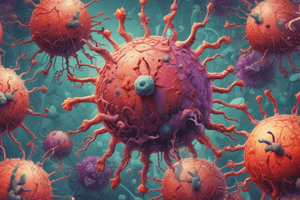Podcast
Questions and Answers
For a virus to initiate a successful infection, sufficient numbers of ______ must enter the host.
For a virus to initiate a successful infection, sufficient numbers of ______ must enter the host.
virions
The affinity for susceptible tissues is known as ______.
The affinity for susceptible tissues is known as ______.
tropism
The most common portal of entry for viruses is the ______ tract.
The most common portal of entry for viruses is the ______ tract.
respiratory
Antibodies of the ______ isotype bind to virus particles in the respiratory tract.
Antibodies of the ______ isotype bind to virus particles in the respiratory tract.
The ______ macrophages are specialized in phagocytosis in the respiratory tract.
The ______ macrophages are specialized in phagocytosis in the respiratory tract.
Viruses are able to gain entry into the body through the ______ tract, among other portals.
Viruses are able to gain entry into the body through the ______ tract, among other portals.
The small intestine contains ______ cells that secrete mucus, which lines the epithelium.
The small intestine contains ______ cells that secrete mucus, which lines the epithelium.
Successful viruses must be resistant to the low pH of ______ acid in the gastrointestinal tract.
Successful viruses must be resistant to the low pH of ______ acid in the gastrointestinal tract.
Localized infections occur when viruses infect and replicate only within ______ at the site of infection.
Localized infections occur when viruses infect and replicate only within ______ at the site of infection.
Congenital infections occur when a mother infects a ______ before its birth.
Congenital infections occur when a mother infects a ______ before its birth.
Intrapartum transmission occurs when the child is infected during the ______ process due to contact with the mother's infected blood, secretions, or biological fluids.
Intrapartum transmission occurs when the child is infected during the ______ process due to contact with the mother's infected blood, secretions, or biological fluids.
Vertical transmission of HIV most often occurs by intrapartum transmission, although ______ can also transmit the virus via the gastrointestinal tract.
Vertical transmission of HIV most often occurs by intrapartum transmission, although ______ can also transmit the virus via the gastrointestinal tract.
Pregnant mother may be encouraged to deliver the child by ______ if there are active signs of maternal infection.
Pregnant mother may be encouraged to deliver the child by ______ if there are active signs of maternal infection.
Herpesviruses, which remain in ______ or cells in a dormant state after infecting a healthy host, are common viral pathogens in transplants.
Herpesviruses, which remain in ______ or cells in a dormant state after infecting a healthy host, are common viral pathogens in transplants.
Rhinovirus infects the ______ cells of the upper respiratory tract and replicates there.
Rhinovirus infects the ______ cells of the upper respiratory tract and replicates there.
Several viruses can be transmitted through ______ transfusion, including hepatitis A virus, hepatitis B virus, and hepatitis C virus.
Several viruses can be transmitted through ______ transfusion, including hepatitis A virus, hepatitis B virus, and hepatitis C virus.
A host typically goes through four stages of disease development when it is infected with a ______.
A host typically goes through four stages of disease development when it is infected with a ______.
The time between when the virus initially infects the host and when symptoms appear is called the ______ period.
The time between when the virus initially infects the host and when symptoms appear is called the ______ period.
During the prodromal period, the virus is replicating quickly within the ______.
During the prodromal period, the virus is replicating quickly within the ______.
The illness period occurs when specific symptoms of the disease ______.
The illness period occurs when specific symptoms of the disease ______.
During the convalescent period, the symptoms of the disease ______ as the host begins feeling better.
During the convalescent period, the symptoms of the disease ______ as the host begins feeling better.
Rhinovirus is a cause of the common ______.
Rhinovirus is a cause of the common ______.
The average incubation period of the Rhinovirus is around ______ hours.
The average incubation period of the Rhinovirus is around ______ hours.
The period of communicability for Influenza A virus is from ______ hours before to 5-10 days after symptoms begin.
The period of communicability for Influenza A virus is from ______ hours before to 5-10 days after symptoms begin.
The contagious period for measles starts ______ days before the onset of rash.
The contagious period for measles starts ______ days before the onset of rash.
The period of communicability for HIV is from early during infection and continues ______.
The period of communicability for HIV is from early during infection and continues ______.
The hepatitis A virus is communicable from the last half of the ______ period to a week into jaundice.
The hepatitis A virus is communicable from the last half of the ______ period to a week into jaundice.
The average incubation period of the Hepatitis B virus is around ______ months.
The average incubation period of the Hepatitis B virus is around ______ months.
The replication and persistence of a virus within a host generally follow one of two different patterns of ______.
The replication and persistence of a virus within a host generally follow one of two different patterns of ______.
Acute infection is typically cleared by the immune system within ______ days.
Acute infection is typically cleared by the immune system within ______ days.
Some acute infections are inapparent or ______, meaning that they produce no symptoms of disease
Some acute infections are inapparent or ______, meaning that they produce no symptoms of disease
Persistent infections can also result from ______ or slow infections.
Persistent infections can also result from ______ or slow infections.
Viral latency is a state in which the virus becomes ______ within host cells.
Viral latency is a state in which the virus becomes ______ within host cells.
For example, varicella zoster virus that causes chickenpox; Later in life, reactivation occur causes the painful skin rash known as ______.
For example, varicella zoster virus that causes chickenpox; Later in life, reactivation occur causes the painful skin rash known as ______.
HIV establishes a slow infection: it takes around 8–10 years for an individual to progress to a stage of disease where symptoms are ______.
HIV establishes a slow infection: it takes around 8–10 years for an individual to progress to a stage of disease where symptoms are ______.
Due to ______ of the immune system, HIV infects immune cells and interferes with their proper functioning.
Due to ______ of the immune system, HIV infects immune cells and interferes with their proper functioning.
Flashcards are hidden until you start studying
Study Notes
Virus Transmission
- Viral pathogenesis is the process by which viruses cause disease within a host.
- For a virus to initiate a successful infection, sufficient numbers of virions must enter the host, and the host cells must be accessible to the virus and susceptible to infection.
Portals of Virus Entry
- Respiratory tract: the most common portal of entry, with viruses contained in larger droplets being deposited in the upper respiratory tract, and smaller aerosolized particles or liquids traveling into the lower respiratory tract.
- Gastrointestinal tract: viruses must be resistant to the low pH of stomach acid and the detergent qualities of bile.
- Skin: viruses can gain entry through the skin, including through cuts or wounds.
- Placenta: congenital infections occur when a mother infects a fetus before its birth, which can lead to severe effects such as miscarriage, low birth weight, intellectual deficiencies, hearing loss, and death of the infant.
- Transplants: viruses can be transmitted through blood transfusions, including hepatitis A, B, and C viruses, HIV, West Nile virus, and dengue virus.
Dissemination Within a Host
- Localized infections: viruses that infect and replicate only within cells at the site of infection, causing localized infections.
- Systemic infections: viruses that spread throughout the body, causing systemic infections.
Patterns of Infection
- A host typically goes through four stages of disease development when infected with a virus:
- Incubation period: the time between when the virus initially infects the host and when symptoms appear.
- Prodromal period: occurs after the incubation period and is when symptoms first appear.
- Illness period: occurs when specific symptoms of the disease occur.
- Convalescent period: the symptoms of the disease subside as the host begins feeling better.
Replication and Persistence of a Virus
- Acute infection: the virus replicates rapidly within the host and is spread to other individuals, but the immune system clears the virus within 7-10 days.
- Persistent infections: occur when the host immune system is unable to effectively clear the virus, but the virus does not replicate to levels that kill the host.
- Viral latency: a state in which the virus becomes dormant within host cells.
- Slow infections: viruses can take years to reach a symptomatic phase, such as HIV, which takes around 8-10 years to progress to a stage of disease where symptoms are apparent.
Studying That Suits You
Use AI to generate personalized quizzes and flashcards to suit your learning preferences.




